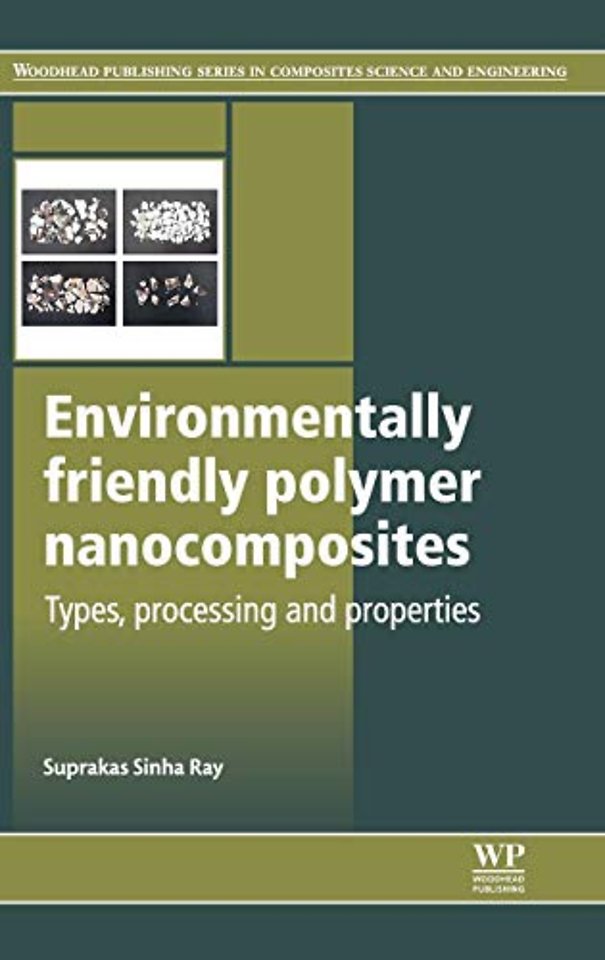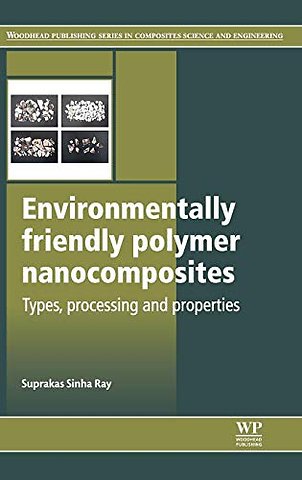<p>About the author</p> <p>Woodhead Publishing Series in Composites Science and Engineering</p> <p>Preface</p> <p>Part I: Types, processing and characterization</p> <p>Chapter 1: Introduction to environmentally friendly polymer nanocomposites</p> <p>Abstract:</p> <p>1.1 Introduction</p> <p>1.2 Defining environmentally friendly polymer nanocomposites</p> <p>1.3 Environmentally friendly polymer matrices</p> <p>1.4 Environmentally friendly nanofillers/reinforcements</p> <p>1.5 Processing of environmentally friendly polymer nanocomposites</p> <p>1.6 Solution-blending and in-situ polymerization</p> <p>1.7 Melt-blending</p> <p>1.8 Performance and potential of environmentally friendly polymer nanocomposites</p> <p>Chapter 2: Environmentally friendly polymer matrices for composites</p> <p>Abstract:</p> <p>2.1 Introduction</p> <p>2.2 Mechanisms of biodegradation and classification of biodegradable polymers</p> <p>2.3 Biodegradable polymers derived from renewable sources</p> <p>2.4 Biodegradable polymers derived from fossil-fuel resources</p> <p>2.5 Summary: using biodegradable polymers as matrices</p> <p>Chapter 3: Environmentally friendly nanofillers as reinforcements for composites</p> <p>Abstract:</p> <p>3.1 Introduction</p> <p>3.2 Nanoclays as reinforcements</p> <p>3.3 Carbon nanotubes (CNTs) as reinforcements</p> <p>Chapter 4: Techniques for characterizing the structure and properties of polymer nanocomposites</p> <p>Abstract:</p> <p>4.1 Introduction</p> <p>4.2 X-ray diffraction (XRD) and small-angle X-ray scattering (SAXS)</p> <p>4.3 Transmission electron microscopy (TEM) and electron tomography</p> <p>4.4 Scanning transmission electron microscopy (STEM)</p> <p>4.5 Scanning electron microscopy (SEM) and focused-ion beam SEM (FIB-SEM)</p> <p>4.6 Atomic force microscopy (AFM)</p> <p>4.7 Optical microscopy (OM) and polarized optical microscopy (POM)</p> <p>4.8 Infrared (IR) spectroscopy</p> <p>4.9 Other techniques</p> <p>Chapter 5: Environmentally friendly polymer nanocomposites using polymer matrices from renewable sources</p> <p>Abstract:</p> <p>5.1 Introduction</p> <p>5.2 Poly(lactic acid) (PLA)-based polymer nanocomposites</p> <p>5.3 Polyalkanoate (PHA)-based polymer nanocomposites</p> <p>5.4 Starch-based polymer nanocomposites</p> <p>5.5 Cellulose-based polymer nanocomposites</p> <p>5.6 Chitosan-based polymer nanocomposites</p> <p>5.7 Protein-based polymer nanocomposites</p> <p>Chapter 6: Environmentally friendly polymer nanocomposites using polymer matrices from fossil fuel sources</p> <p>Abstract:</p> <p>6.1 Introduction</p> <p>6.2 Poly(butylene succinate) (PBS)-based polymer nanocomposites</p> <p>6.3 Poly[(butylene succinate)-co-adipate] (PBSA)-based polymer nanocomposites</p> <p>6.4 Poly(e -caproloctone) (PCL)-based polymer nanocomposites</p> <p>6.5 Poly(butylene adipate-co-terephthalate) nanocomposites</p> <p>6.6 Nanocomposites of other biodegradable polyesters</p> <p>Chapter 7: Processing of environmentally friendly polymer nanocomposite foams for packaging and other applications</p> <p>Abstract:</p> <p>7.1 Introduction</p> <p>7.2 Preparation, characterization and properties of environmentally friendly polymer nanocomposite (EFPN) foams</p> <p>Part II: Properties</p> <p>Chapter 8: Tensile properties of environmentally friendly polymer nanocomposites using biodegradable polymer matrices and clay/carbon nanotube (CNT) reinforcements</p> <p>Abstract:</p> <p>8.1 Introduction</p> <p>8.2 Tensile properties of environmentally friendly polymer nanocomposites (EFPNCs) using clay reinforcements</p> <p>8.3 Tensile properties of EFPNCs using carbon nanotube (CNT) reinforcements</p> <p>Chapter 9: Dynamic mechanical properties of environmentally friendly polymer nanocomposites using biodegradable polymer matrices and clay/carbon nanotube (CNT) reinforcements</p> <p>Abstract:</p> <p>9.1 Introduction</p> <p>9.2 Dynamic mechanical properties of environmentally friendly polymer nanocomposites using clay reinforcements</p> <p>9.3 Dynamic mechanical properties of environmentally friendly polymer nanocomposites using carbon nanotube (CNT) reinforcements</p> <p>Chapter 10: Thermal stability and flammability of environmentally friendly polymer nanocomposites using biodegradable polymer matrices and clay/carbon nanotube (CNT) reinforcements</p> <p>Abstract:</p> <p>10.1 Introduction</p> <p>10.2 Thermal stability of environmentally friendly polymer nanocomposites using clay reinforcements</p> <p>10.3 Thermal stability of environmentally friendly polymer nanocomposites using carbon nanotube (CNT) reinforcements</p> <p>10.4 Fire resistant properties of environmentally friendly polymer nanocomposites using biodegradable polymer matrices and clay/carbon nanotube (CNT) reinforcements</p> <p>Chapter 11: Barrier properties of environmentally friendly polymer nanocomposites using biodegradable polymer matrices and clay/carbon nanotube (CNT) reinforcements</p> <p>Abstract:</p> <p>11.1 Introduction</p> <p>11.2 Gas barrier properties</p> <p>11.3 Water vapor permeability and water swelling behavior</p> <p>Chapter 12: Crystallization behavior, kinetics and morphology of environmentally friendly polymer nanocomposites using biodegradable polymer matrices and clay/carbon nanotube (CNT) reinforcements</p> <p>Abstract:</p> <p>12.1 Introduction</p> <p>12.2 Isothermal and non-isothermal crystallization kinetics</p> <p>12.3 Crystallization of clay-reinforced polymer nanocomposites</p> <p>12.4 Crystallization of carbon nanotube (CNT)-reinforced polymer nanocomposites</p> <p>Chapter 13: Biodegradation behavior of environmentally friendly polymer nanocomposites using biodegradable polymer matrices and clay/carbon (CNT) reinforcements</p> <p>Abstract:</p> <p>13.1 Introduction</p> <p>13.2 Biodegradation behavior of environmentally friendly polymer nanocomposites using clay reinforcements</p> <p>13.3 Biodegradable behavior of environmentally friendly polymer nanocomposites using carbon nanotube (CNT) reinforcements</p> <p>Chapter 14: Rheological properties of environmentally friendly polymer nanocomposites (EFPNCs) using biodegradable polymer matrices and clay/carbon nanotube (CNT) reinforcements</p> <p>Abstract:</p> <p>14.1 Introduction</p> <p>14.2 Dynamic oscillatory shear measurements</p> <p>14.3 Steady shear measurements</p> <p>14.4 Elongation flow rheology</p> <p>Chapter 15: Electrical and thermal conductivity of environmentally friendly polymer nanocomposites (EFPNCs) using biodegradable polymer matrices and clay/carbon nanotube (CNT) reinforcements</p> <p>Abstract:</p> <p>15.1 Introduction</p> <p>15.2 Electrical conductivity</p> <p>15.3 Thermal conductivity</p> <p>Part III: Summary</p> <p>Chapter 16: Applications, environmental impact and future development of environmentally friendly polymer nanocomposites (EFPNCs)</p> <p>Abstract:</p> <p>16.1 Introduction</p> <p>16.2 Applications of environmentally friendly polymer nanocomposites</p> <p>16.3 Assessing the environmental impact of environmentally friendly polymer nanocomposites</p> <p>16.4 Current challenges facing environmentally friendly polymer nanocomposites</p> <p>16.5 Future trends</p> <p>Index</p>

